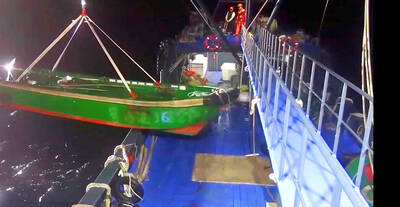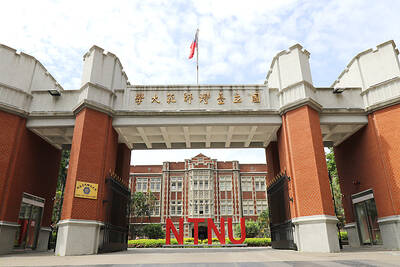The Matsu Islands -- a long-time defense post about 210km northwest of Taiwan's northern tip and just outside the estuary of the Min River in China's Fujian Province -- is now acting more as an environmental guard post for Taiwan than as a military bastion.
The Environmental Protection Administration has since 1999 operated an air-quality monitoring system in Matsu. In 2001 the administration upgraded the system with advanced precision instruments that measure airborne pollutants in order to provide early warnings about sandstorms.

PHOTO: CHIU YU-TZU, TAIPEI TIMES
The administration is also assisting Matsu authorities and residents in tackling the problem of water-borne waste from China. Because of lax environmental regulations in China, the islands are being swamped with Chinese junk -- ranging from from bottles to animal carcasses to human bodies.
According to Chen Hsiu-hua (陳秀華), director-general of Lienchiang County's Environmental Protection Bureau, an air-quality monitoring system in Nankan will soon be relocated to a nearby site. The move will make it more sensitive to pollutants from China.
"Information about Chinese sandstorms that we gather here in Matsu gives Taiwan three to four hours to prepare for a possible strike of bad air," Chen said.
The station is capable of making precise measurements of fine particulate matter (known as PM10) and long-range air pollutants of concern, including ozone, sulfur dioxide and carbon monoxide, according to Chu Yu-chi (
Despite dust created by 130 construction sites, Matsu does not produce an excessive amount of air pollutants, environmental officials said. On the Pollutant Standards Index -- on which a score of 100 or higher is considered unhealthy for humans, especially those who suffer from asthma or other respiratory diseases -- the average reading in Matsu ranges between 20 and 40.
PSI is calculated based on concentrations of a variety of pollutants, including PM10 matter, sulfur dioxide, nitrogen dioxide, carbon monoxide and ozone.
However, PSI levels on Matsu increase significantly -- to 100 or higher -- when Chinese sandstorms send pollutants to the islands. Since 2001, there have been five days on which PSI levels have exceeded 100.
"Air quality information from Matsu makes it possible for Taiwanese residents to take necessary precautions during times of bad air quality. But the long-range transportation of other kinds of pollutants from China deserves more attention," said Lin Neng-huei (
Extremely dry conditions in the deserts of Central Asia and Mongolia often trigger sandstorms during the winter. Scientists have said that desertification caused the Gobi Desert to expand at a rate of 2.4 percent per year in the late 1990s.
As the Gobi Desert creeps south, not only China's heartland but also neighboring countries are being hammered with increasingly regular sandstorms.
The phenomenon has triggered research about transcontinental sandstorms in many countries, including Taiwan, South Korea and Japan.
In Taiwan, sandstorms from China were first noticed in April 1988, when the concentration of particulate matter in the air increased dramatically. In recent years, sandstorms have become more frequent due to drought and overgrazing in China.
Because Taiwan appears to suffer disproportionately from Chinese sandstorms, university researchers affiliated with the administration have since 2001 been charged with conducting in-depth research and analyzing data collected by satellite, laser radar and air quality monitoring stations.
In February, the EPA's research into Chinese sandstorms suggested that various kinds of fungi, originating in Mongolia, were being carried via sandstorms to Taiwan. However, a correlation between the presence of fungi in sandstorms and the transmission of human disease remains unclear.
Lin said that if a new air-quality monitoring system could be established somewhere in the area of Jade Mountain at about 3,000m above sea level, air-quality data collected in Matsu and elsewhere in Taiwan would become relatively complete.
"Regional air-quality data collected in East Asia, including eastern China and Taiwan, could be analyzed together with that available in Hawaii. Our portrait of long-range transportation of airborne pollutants would become clearer," Lin said.
In addition to airborne pollutants, the EPA has also assisted Matsu residents in fighting water-borne waste from China.
In the last decade, Matsu residents have suffered the ill effects of rapid industrialization in China. The lack of advanced landfill technologies in China has resulted in coastal pollution in Matsu.
At a Chukuang Township pier where tourists go ashore to visit a lighthouse built in 1842 by British engineers, floating garbage seems to dampen both the visitors' and the hosts' spirits.
"The situation during rainy times is really awful," said Chukuang Township Chief Wang Ta-chieh (
Water-borne waste from China usually arrives in the Matsu Islands between November and January because of the wind direction in winter. Heavy rain during the typhoon season also boosts the amount of garbage from China.
According to Chen Yu-li (陳玉利), a specialist with the county's Environmental Protection Bureau, about 296 tonnes of waste from China's Fujian Province were collected by sanitation workers in Matsu last year. Nearly three-quarters of it was wood, straw, leaves, seaweed and other natural materials flushed down the Min River.
But Chen said that the waste also included medical equipment, clothes, bottles, cans, and the carcasses of animals such as chickens, pigs and sheep. Human bodies have been found from time to time.
"Sometimes fishing boats have malfunctioned simply because of running into fishing nets that people have thrown away," Chen Yu-li said.
Also, because it lies among heavily-trafficked shipping routes, Matsu suffers from litter that comes from merchant marine vessels.
The local government in the spring and fall carries out voluntary activities in which residents and soldiers clean the beaches -- but mountains of garbage remain.
Last October, residents of Nioujiao Village in Nankan, which is particularly hard hit by water-borne Chinese waste, decided to protect their coast by building a floating boom. They lashed together barrels in a line about 300m from the coast to prevent Chinese waste from floating into their village.
Marina Cheng (

Taiwan yesterday condemned the recent increase in Chinese coast guard-escorted fishing vessels operating illegally in waters around the Pratas Islands (Dongsha Islands, 東沙群島) in the South China Sea. Unusually large groupings of Chinese fishing vessels began to appear around the islands on Feb. 15, when at least six motherships and 29 smaller boats were sighted, the Coast Guard Administration (CGA) said in a news release. While CGA vessels were dispatched to expel the Chinese boats, Chinese coast guard ships trespassed into Taiwan’s restricted waters and unsuccessfully attempted to interfere, the CGA said. Due to the provocation, the CGA initiated an operation to increase

CHANGING LANDSCAPE: Many of the part-time programs for educators were no longer needed, as many teachers obtain a graduate degree before joining the workforce, experts said Taiwanese universities this year canceled 86 programs, Ministry of Education data showed, with educators attributing the closures to the nation’s low birthrate as well as shifting trends. Fifty-three of the shuttered programs were part-time postgraduate degree programs, about 62 percent of the total, the most in the past five years, the data showed. National Taiwan Normal University (NTNU) discontinued the most part-time master’s programs, at 16: chemistry, life science, earth science, physics, fine arts, music, special education, health promotion and health education, educational psychology and counseling, education, design, Chinese as a second language, library and information sciences, mechatronics engineering, history, physical education

The Chinese military has boosted its capability to fight at a high tempo using the element of surprise and new technology, the Ministry of National Defense said in the Quadrennial Defense Review (QDR) published on Monday last week. The ministry highlighted Chinese People’s Liberation Army (PLA) developments showing significant changes in Beijing’s strategy for war on Taiwan. The PLA has made significant headway in building capabilities for all-weather, multi-domain intelligence, surveillance, operational control and a joint air-sea blockade against Taiwan’s lines of communication, it said. The PLA has also improved its capabilities in direct amphibious assault operations aimed at seizing strategically important beaches,

‘MALIGN PURPOSE’: Governments around the world conduct espionage operations, but China’s is different, as its ultimate goal is annexation, a think tank head said Taiwan is facing a growing existential threat from its own people spying for China, experts said, as the government seeks to toughen measures to stop Beijing’s infiltration efforts and deter Taiwanese turncoats. While Beijing and Taipei have been spying on each other for years, experts said that espionage posed a bigger threat to Taiwan due to the risk of a Chinese attack. Taiwan’s intelligence agency said China used “diverse channels and tactics” to infiltrate the nation’s military, government agencies and pro-China organizations. The main targets were retired and active members of the military, persuaded by money, blackmail or pro-China ideology to steal